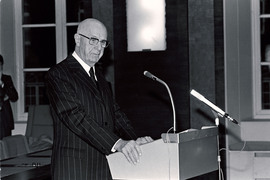While recognizing that the international environment had changed since 1949, the Report reaffirmed the aims and purpose of NATO and its twin functions - political and military. It also introduced a new dimension, committing the Alliance to a dual-track policy: it advocated the need to seek a relaxation of tensions of East-West relations while maintaining adequate defence, i.e., military defence deterrents would be balanced alongside political détente.
For the political dimension, there was a plea for balanced force reductions in the East and West, as well as a solution to the underlying political problems dividing Europe in general and Germany in particular; for the military dimension, the Report spoke of examining “exposed areas”, citing in particular the Mediterranean.
Its namesake, Belgian Foreign Minister Pierre Harmel, originally highlighted the need for the report in 1966, at a time when the existence of the Alliance was put into question. Four separate reports were initially drafted and, consequently, summarized. It was this summary that constituted the Report, which was presented and unanimously approved by defence ministers in December 1967.
The impact of the Report was both short-term and long-term. In the late 60s, NATO was under increased public scrutiny: France had withdrawn from the integrated military command structure and, for some, 1969 marked the end of the Alliance or, at least, of the Alliance as it had existed up to then (a belief fed by a misinterpretation of Article 13 of the North Atlantic Treaty). The Report not only reiterated the Organization’s key principles, but it also set out a realistic programme of work, therefore reasserting the existence of NATO in a practical as well as a political way.
In the long term, the Report had a lasting impact on the Alliance’s strategic thinking. Building on the Report of the Three Wise Men (1956), it broadened the Organization’s approach to security, anticipating the breakdown of the deadlock between the East and West.

